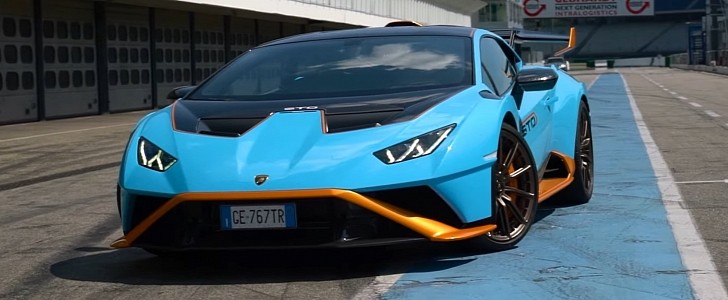While customer test drives of the Lamborghini Huracan STO have officially started in its home country, over in Germany, the supercar was put through its paces on the track, against the clock.
SportAuto gave the keys of the Italian model, which was equipped with Bridgestone Potenza Race tires, to Christian Gebhardt. The experienced driver was tasked with lapping the Hockenheim GP as fast as he could, and at the end of the run, he posted 1:48.60.
To better understand what this lap time means, we took a look on the FastestLaps website, and found that the Huracan STO was actually one tenth of a second slower than the Mercedes-AMG GT R, driven by Uwe Sener. It failed to beat the McLaren 720S too, which posted 1:48.20, as well as the Mercedes-AMG GT R Pro with its 1:48.00, put through its paces by Gebhardt.
Other supercars that turned out to be quicker than the said Lambo were the Porsche 992 Turbo S, with 1:47.80, Lamborghini Aventador SVJ, with 1:47.30, and McLaren 765LT, with 1:46.20. All of them were driven by Gebhardt too, and so was the Mercedes-AMG GT Black Series, which at 1:43.30, came behind the McLaren Senna, which is the unofficial king for production cars at the German racetrack, with 1:40.79.
On a more positive note, the Huracan STO was a bit quicker than the McLaren 600LT, Huracan Evo, and Porsche 991 GT2 RS, which did 1:48.90, 1:49.00, and 1:49.10 respectively. The Ferrari 458 Speciale is listed with 1:51.44, and the Audi R8 V10 Performance with 1:52.20.
A track-focused supercar, the Huracan STO boasts a lot of mods over the regular models, including updated aerodynamics, stiffer suspension, more responsive transmission, sharper steering, and additional driving modes.
Power is supplied by the same naturally aspirated 5.2-liter V10, which pumps out 631 HP and 417 lb-ft (565 Nm) of torque, rocketing it from 0 to 62 mph (0-100 kph) in 3.0 seconds, and up to 193 mph (310 kph).
To better understand what this lap time means, we took a look on the FastestLaps website, and found that the Huracan STO was actually one tenth of a second slower than the Mercedes-AMG GT R, driven by Uwe Sener. It failed to beat the McLaren 720S too, which posted 1:48.20, as well as the Mercedes-AMG GT R Pro with its 1:48.00, put through its paces by Gebhardt.
Other supercars that turned out to be quicker than the said Lambo were the Porsche 992 Turbo S, with 1:47.80, Lamborghini Aventador SVJ, with 1:47.30, and McLaren 765LT, with 1:46.20. All of them were driven by Gebhardt too, and so was the Mercedes-AMG GT Black Series, which at 1:43.30, came behind the McLaren Senna, which is the unofficial king for production cars at the German racetrack, with 1:40.79.
On a more positive note, the Huracan STO was a bit quicker than the McLaren 600LT, Huracan Evo, and Porsche 991 GT2 RS, which did 1:48.90, 1:49.00, and 1:49.10 respectively. The Ferrari 458 Speciale is listed with 1:51.44, and the Audi R8 V10 Performance with 1:52.20.
A track-focused supercar, the Huracan STO boasts a lot of mods over the regular models, including updated aerodynamics, stiffer suspension, more responsive transmission, sharper steering, and additional driving modes.
Power is supplied by the same naturally aspirated 5.2-liter V10, which pumps out 631 HP and 417 lb-ft (565 Nm) of torque, rocketing it from 0 to 62 mph (0-100 kph) in 3.0 seconds, and up to 193 mph (310 kph).








